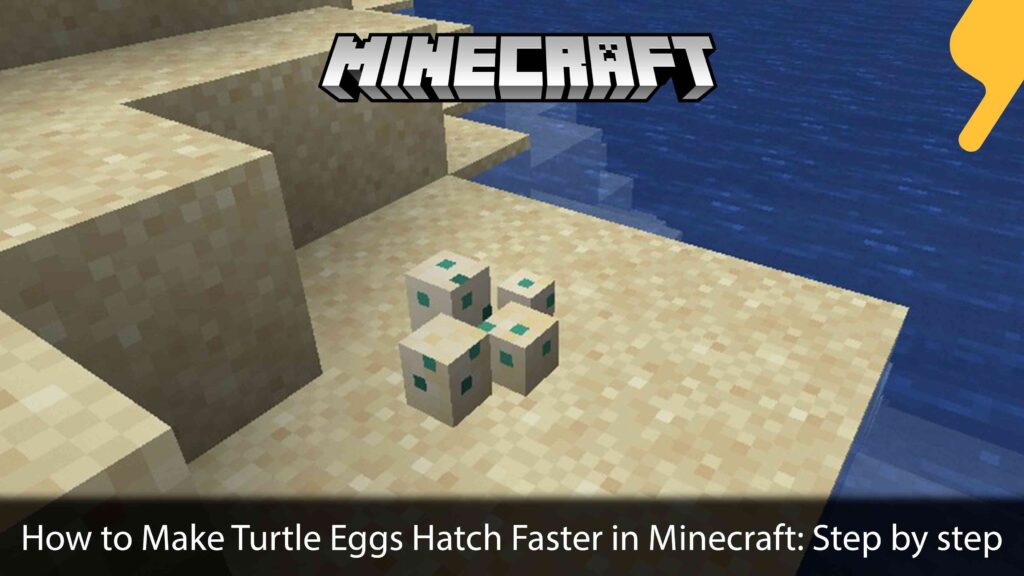Minecraft, a game of creativity and survival, offers diverse experiences. One intriguing aspect is turtle breeding. Turtle eggs, integral to the process, often leave players waiting for them to hatch. This guide delves into hastening that process.
Understanding Turtle Behavior in Minecraft
Turtles are passive mobs that spawn naturally in warm ocean biomes, such as lukewarm oceans, deep lukewarm oceans, warm oceans, or deep warm oceans. They can also spawn on beaches adjacent to these biomes.
Turtles are usually found in groups of 2-6 on the sand near the water. They have green shells, brown skin, and black eyes. They have 30 health points (15 hearts) and can swim in water or walk on land.
Turtles are not hostile to players or other mobs, unless they are attacked or their eggs are destroyed. They will then retaliate by biting the attacker with their powerful jaws.
Turtles have some unique behaviors that you should know about:
• Turtles have a home beach, which is the beach where they spawned or hatched. Turtles will always return to their home beach to lay their eggs, even if they are far away from it.
• Turtles can be tamed by feeding them seagrass, which is a type of underwater plant that can be found in ocean biomes or rivers. Seagrass can be harvested using shears or silk touch tools.
• Tamed turtles will follow you around and obey your commands. You can also breed tamed turtles with other tamed turtles using seagrass.
• Turtles can be attached to a lead or named with a name tag to keep them from wandering off.
• Turtles can be transported using boats or minecarts, but they will try to escape if they are not on their home beach.
What to Do With Turtle Eggs in Minecraft?
Turtle eggs are items that are laid by turtles on the sand after they mate. Their eggs can hatch into baby turtles, which will grow into adult turtles and drop scutes when they do.
Turtle eggs have some uses and purposes that you should know about:
• Turtle eggs can be used to breed more turtles by placing them on sand or red sand blocks near water.
•Eggs can be used to attract zombies and other hostile mobs that will try to trample or break them. This can be used as a trap or a bait for mob farms or defenses.
• Turtle eggs can be used to craft turtle shells or turtle master potions using scutes dropped by baby turtles.
• Turtle eggs can be used as a decorative item or a trophy by placing them on item frames or armor stands.
Where to Find Turtles in Minecraft?
Turtles are passive mobs that spawn naturally in warm ocean biomes, such as lukewarm oceans, deep lukewarm oceans, warm oceans, or deep warm oceans. They can also spawn on beaches adjacent to these biomes.
To find turtles in Minecraft, you need to follow these tips:
• Use a map or a compass to locate warm ocean biomes or beaches near them. You can also use the /locatebiome command or a biome finder tool to find them.
• Explore the ocean or the beach using a boat or a dolphin. You can also use a potion of water breathing or a turtle shell to swim underwater.
• Look for turtles on the sand near the water. They are usually found in groups of 2-6 and have green shells, brown skin, and black eyes.
• Use a lead or a name tag to capture and transport the turtles to your base or farm. You can also use a boat or a minecart to move them, but they will try to escape if they are not on their home beach.
Breeding Turtles: The First Step
Turtles can breed with other turtles of the same species after they are tamed by players using seagrass. Breeding turtles will produce turtle eggs, which can hatch into baby turtles.
To breed turtles, you need to follow these steps:
1.
Find two tamed turtles on a beach or in an ocean biome.
2.
Feed each turtle some seagrass until they show some heart particles.
3.
The two turtles will then move closer to each other and mate.
4.
After mating, one of the turtles (usually the female) will dig into the sand and lay 1-4 turtle eggs.
5.
The turtle will then cover the eggs with sand and return to the water.
Their eggs are items that are laid by turtles on the sand after they mate. Turtle eggs have a greenish-brown color and a round shape. They have three stages of development: unhatched, cracked, and hatched.
Turtle eggs can only be laid on sand or red sand blocks. They cannot be laid on any other type of block or surface.
Turtle eggs can only be laid by turtles that have a home beach, which is the beach where they spawned or hatched. Turtles will always return to their home beach to lay their eggs, even if they are far away from it.
Eggs can be picked up by players using a silk touch tool, such as a silk touch pickaxe or shovel. Their eggs can also be obtained by using the /give command or by using a spawn egg in creative mode.
Turtle Eggs: The Basics
Turtle eggs are items that are laid by turtles on the sand after they mate. Their eggs can hatch into baby turtles, which will grow into adult turtles and drop scutes when they do.
Eggs have some basic properties and mechanics that you should know about:
• Turtle eggs have a very slow hatching speed, which can take several in-game nights to complete. Turtle eggs hatch only when they are placed on sand or red sand blocks and when they are exposed to the night sky.
• Turtle eggs have three stages of development: unhatched, cracked, and hatched. Each stage has a different appearance and sound. Unhatched eggs have no cracks and make no sound. Cracked eggs have one or two cracks and make cracking sounds. Hatched eggs have three cracks and make hatching sounds.
• Turtle eggs have different sizes depending on the number of eggs in a cluster. The more turtle eggs there are in a cluster, the faster they will hatch. The maximum number of turtle eggs in a cluster is four.

Creating the Optimal Environment for Hatching
Turtle eggs are very fragile and vulnerable to predators and environmental hazards. Turtle eggs can be destroyed by zombies and other hostile mobs that will try to trample or break them. It can also be destroyed by players or other mobs that will try to attack or step on them. It will be destroyed by water or lava that will wash away or burn them. They can also be destroyed by falling blocks or explosions that will crush or blast them.
Speeding Up the Hatching Process
Want swifter hatching? Adjust the game’s random tick speed. While the default is three, increasing this number hastens growth. But, be cautious, as this impacts other in-game processes.
Caring for the Hatchlings
n the expansive world of Minecraft, breeding turtles and waiting for their eggs to hatch is just half the battle. Once the tiny baby turtles emerge, caring for these hatchlings becomes crucial.
Baby turtles, or hatchlings, are among the most vulnerable entities in the game. Their small size means they’re susceptible to threats from hostile mobs like zombies, skeletons, and drowned. Protection is paramount. Consider building a sand enclosure or fencing around the hatching area to shield them from potential predators.
Apart from external threats, the hatchlings need time to mature. Once they grow into adults, they drop a valuable item known as ‘scute’. This item is a pivotal ingredient for crafting the ‘Turtle Shell’—a piece of headgear that bestows the player with a water-breathing ability.
Why Speed Up the Process?
In the intricate universe of Minecraft, patience is often the name of the game. From mining to building, many tasks require time. So, when it comes to turtle egg hatching, why would one want to hasten the process?
First and foremost, faster hatching equates to quicker access to ‘scutes’, the valuable item dropped by baby turtles as they mature. These scutes are essential in crafting the coveted ‘Turtle Shell’, granting players enhanced underwater capabilities. This speed can be a boon for players looking to delve into oceanic explorations or tackle underwater temples.
Additionally, speeding up the process reduces the window of vulnerability for turtle eggs. The longer eggs are exposed, the higher the chance of them being trampled by hostile mobs. A quickened hatching sequence minimizes these threats, ensuring a higher survival rate.
Potential Issues & Solutions
Issues might arise. Perhaps eggs aren’t hatching, or hostile mobs are incessant. Remember: eggs need sand and sunlight, and a secured perimeter fends off threats.
Tips and Tricks for Turtle Breeding and Hatching
Here are some tips and tricks that can help you breed and hatch turtles faster and easier in Minecraft 1.19:
• Use a turtle egg as a bait to lure zombies and other hostile mobs into a trap or a farm. Zombies and other hostile mobs will try to trample or break turtle eggs, so you can use them to attract them into a pit, a cage, or a killing mechanism.
• Use a turtle shell as a helmet to breathe underwater and resist damage. A turtle shell can be worn as a helmet that provides water breathing and resistance effects. This can be useful for exploring underwater biomes or structures, or for surviving tough situations.
• Use a turtle master potion to become invincible for a short time. A turtle master potion can grant you slowness and resistance effects, making you invincible for a short time. This can be useful for fighting bosses or mobs, or for escaping danger.
• Use commands or cheats to change the time of day or the random tick speed to speed up the hatching process of turtle eggs. Commands and cheats can only be used in creative mode or with cheats enabled. To change the time of day, use the /time set command. To change the random tick speed, use the /gamerule randomTickSpeed command.
Alternative Methods
For those tech-savvy, mods and plugins can modify the hatching process. Research ones compatible with your game edition.
Conclusion
Turtles are passive mobs that spawn naturally in warm ocean biomes or beaches near them. Turtles can drop scutes when they grow from baby turtles to adult turtles. Scutes can be used to craft turtle shells or turtle master potions.
Breeding and hatching turtles can be a fun and enjoyable activity in Minecraft 1.19 that can add more variety and excitement to your gameplay. However, it can also be a tricky and time-consuming process that requires patience and care.
FAQs
- Do other games on PlayStation require PS Plus for multiplayer?
- Yes, most online multiplayer games on PlayStation need PS Plus.
- If I have Minecraft on another platform, can I connect with PlayStation friends without PS Plus?
- It depends on the game’s cross-platform capabilities.
- Are there discounts or promotions for PS Plus?
- Yes, PlayStation often has promotional offers for PS Plus.
- What are the safety measures in place for kids playing Minecraft online?
- Minecraft has various parental controls, including chat filters and privacy settings.
- How does Minecraft on PlayStation compare to other platforms in terms of gameplay experience?
- Gameplay is similar, but controls and exclusive content might differ.








